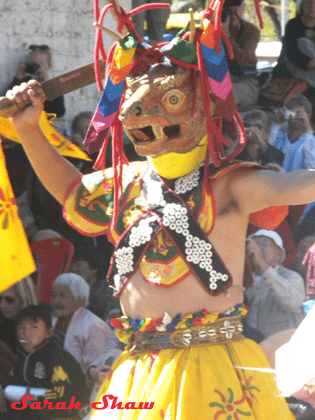 This WanderShopper never seems to do anything in moderation. “Go big or go home” has been one of my rules for living and it was definitely in effect for my first visit to Bhutan a few years ago. I had always been fascinated by Buddhist iconography and had heard so many amazing things about Bhutan. When I learned that the eastern part of the country was going to be opened to tourists, and that I had the chance to be part of only the 4th trek into the region, I jumped feet first. The adventures, and misadventures, of that WanderTours trek are a story for another time. We’ll just leave it for now with the thought that I had never gone on a trek anywhere before let alone the Himalayas. It hadn’t occurred to me that I would require more than the conditioning and day hikes I was doing in oh-so-flat Michigan. After surviving the 6 most physically challenging days of my life thus far, I found myself getting back to some familiar territory as we started to head west through the country.
This WanderShopper never seems to do anything in moderation. “Go big or go home” has been one of my rules for living and it was definitely in effect for my first visit to Bhutan a few years ago. I had always been fascinated by Buddhist iconography and had heard so many amazing things about Bhutan. When I learned that the eastern part of the country was going to be opened to tourists, and that I had the chance to be part of only the 4th trek into the region, I jumped feet first. The adventures, and misadventures, of that WanderTours trek are a story for another time. We’ll just leave it for now with the thought that I had never gone on a trek anywhere before let alone the Himalayas. It hadn’t occurred to me that I would require more than the conditioning and day hikes I was doing in oh-so-flat Michigan. After surviving the 6 most physically challenging days of my life thus far, I found myself getting back to some familiar territory as we started to head west through the country.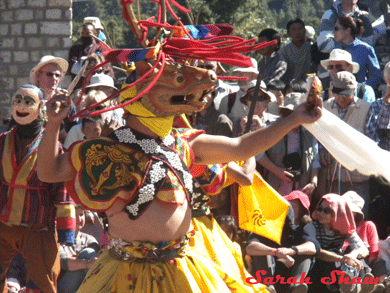
We stopped in Bumthang, in the central part of Bhutan for a couple nights so that we could enjoy the tsechu, or festival, that was going on there at the time. Tsechus serve a very important role in Bhutanese culture as they not only have religious significance but they also serve a social purpose as people travel in from rural areas to gather at the tsechu. Although tsechus are held in many parts of Bhutan, Bumthang is an especially significant location as the original tsechu took place there. The focal point of the festival are the Cham dances which blend meditation and dancing. The original ones were created and performed by Padmasambhava to help successfully restore the health of the dying King Sindhu Raja around the end of the 8th century. The cham dances are performed by costumed and masked dancers and they tell moral vignettes and are based on incidents from Padmasambhava’s life. He is significant as he is the human manifestation of Guru Rinpoche, also known as the second Buddha, who is responsible for spreading Vajrayana Buddhism throughout Bhutan, Nepal and Tibet.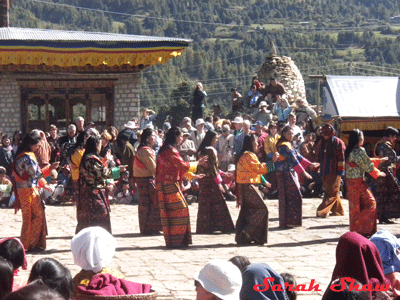
Dancing is a major highlight of the Tsechu. Tourists love to take pictures of the fantastically costumed dancers. The dances are performed in the courtyard outside the temple, Tamshing Lhakhang, in this case. In 2012, it was submitted to be an UNESCO Hertitage Site which should encourage even more visitors to make the journey from the west to central Bhutan. In addition to the sacred dances. there are also numerous folk dances. I enjoyed watching the beautiful Bhutanese women line up in their best kera which is an ankle length dress worn by all women in Bhutan as it is part of the national dress. An open jacket, or toego, is worn over it. The dancing women form two lines and dance and dip in unison, swinging their arms as the softly sing their folk songs. The Bhutanese spectators have arrived early each day of the festival to spread blankets out around the performance area to claim their space for family and friends. They will enjoy picnics of food brought along or purchased from vendors in the festival market set up nearby. Western tourists are also bussed in and line up behind the seated Bhutanese jockeying with other late arrivals to get a vantage point for photographs. I was glad that we stayed at a hotel an easy walk away from the festival.
At night we returned for a very special performance, the naked fire dance. Taking place well after midnight, in part to allow the dancers to consume huge quantities of ara to give them confidence and mask the cold, this sacred dance is viewed only by a few. It is only performed as part of this tsechu. No images are allowed to be taken of the ritual. Monks scour the crowd well in advance of the dance beginning and lecture everyone in the audience that they are not allowed to take pictures or record it in any way. This keeps it special and sacred as well as preserving the modesty of the male performers. There was an amazing energy in the crowd as the anticipated the beginning of the dance.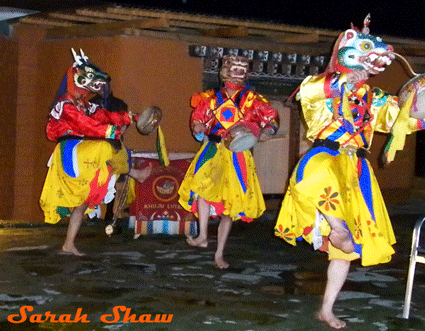
The photo above is from a performance of traditional dances near Paro I attended during another trip to Bhutan. The darkness adds to the drama and excitement of the dance just as it did for the naked fire dance.
When the moment was right, 16 naked men came out to dance around a large bonfire in the middle of the courtyard. Their faces were obscured by white cloth. Some had also attached branches to a white strip of cloth they had tied around their waist. Some would gather in groups of two or three and dance up to members in the crowd, jutting their hips and penises suggestively towards the crowd. The dance is said to help the fertility of women present who have had trouble conceiving. It is also said that those who witness the dance are cleansed from their sins. This dance also honors the tradition set by Padmasambhava when he used the dance to distract and then subdue demons that had been causing havoc in the area. Despite the sexual nature of this dance, I do want to make sure that people know that the Bhutanese are a very modest people. This is reflected by their national dress which completely covers of skin for both men and women.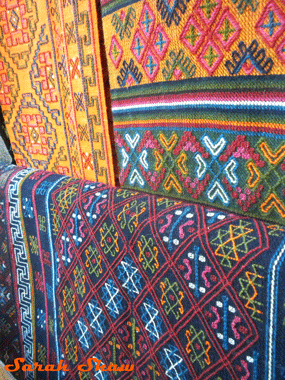
Along with the dancing throughout the teschu, many people really enjoy the market that is set up for the festival. As tsechus are held only in the fall and spring, it gives people in rural areas a chance to come to a larger scale market and purchase items needed. Some are as simple as a new pair of flip flops or clothes for their children. I also saw vendors with appliances including refrigerators. My favorite section included stalls with vintage and craft items. I purchased some beautiful woven items as well as a vintage blanket that had beautiful faded colors. I also discovered a jewelry artist who created beautiful necklaces made from turquoise and red coral, both favorite stones of the Bhutanese. It had a silver chamber in the center where one could place blessed prayers, or mantras.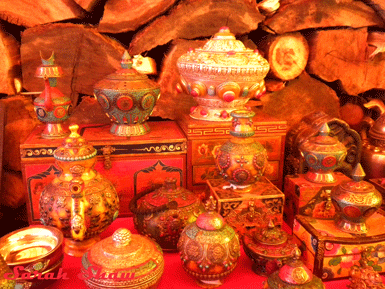
My photographs from the Tsechu market concentrated on a couple stalls offering items for setting up a home altar. Above there is a grouping of prayer wheels. Within in each covered bowl, are prayers or mantras written on paper, sometimes many, many times. The owner will grasp the knob at the top and spin it clockwise. With each rotation, the prayers are then released out into the universe to better the individual as well as all other living beings. The number of times the prayer is written is multiplied by the number of rotations. In this way, more prayers can be completed than would be easily said out loud allowing merit to be accumulated more quickly. They are decorated with favorite motifs including the eight treasures.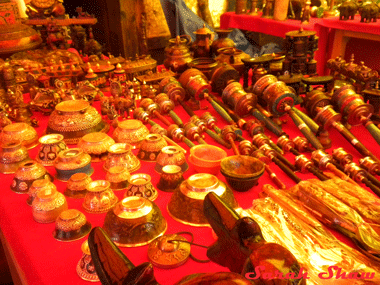
Prayer wheels also appear in the photograph above. These are mounted on a handle and are to be gripped in the hand. By moving your wrist, you cause the prayer wheel to rotate clockwise again releasing prayers into the universe. I regularly saw elderly Bhutanese men and women gathered in temples or next to large prayer wheels, mediating and spinning one’s just like these for hours a day. On the left side of the photograph is a selection of offering bowls. On your home altar, you would usually have seven offering bowls like these which you would replenish each day. They would be lined up in a row. Three of the bowls would contain water and the others would hold incense, flowers and a conch shell.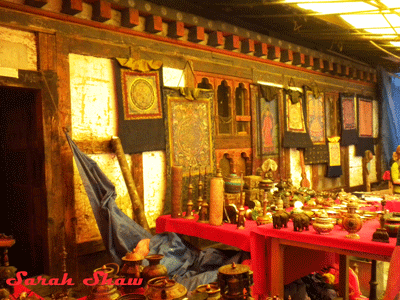
Another item for sale in this stall were thangkas. You can see them hanging along the back wall. Thangkas are portable paintings of Buddhist deities. The paintings can be very detailed and incorporate a lot of meaningful images and symbols for the owner to use during meditation and prayers. You might choose to hang it behind your home altar. The painting is mounted to brocade fabric and can be rolled up as needed for journeys. There is usually another piece of fabric that hangs down to cover the painting. It is there to protect the image from light as well as soot and smoke from incense and butter lamps. Additional strips of fabric hang down and are to be used to secure the rolled up cover decoratively when the image is to be viewed. Old and detailed thangkas can be quite pricey and may be the most expensive souvenir purchase while in Bhutan. Thangkas are an important part of tsechus as many festivals include the unveiling of the dzongs’ thangka which may be several stories in height. It is usually only shown for a day each year and is very important for pilgrims to view. I purchases a newly painted thangka of White Tara later in my trip once I reached Thimphu.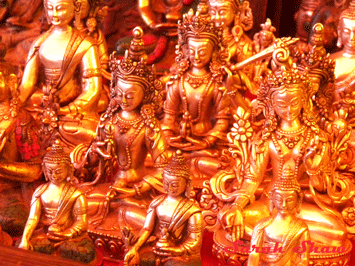
One of my favorite photos from the market is the collection of figures above. They are bronze statues of Tara and the Medicine Buddha. Meant to be a meditation image, Tara symbolizes compassion and understanding in Buddhism. The Medicine Buddha is also a popular image representing powers of healing. People making pilgrimages to a tsechu may find special meaning in these statues and they are small enough to travel easily back to their homes.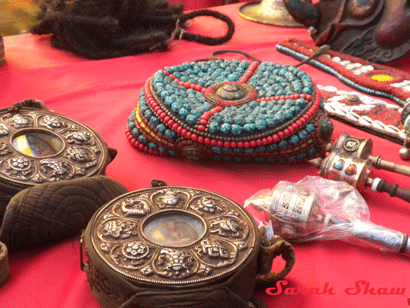
The final image I will share from this festival market contains prayer wheels, a hat and the container above. I do not remember exactly what was inside. I would guess that it may contain offering bowls and be a portable altar. In the center is on of the meditation deities. It is surrounded by the eight treasures. If you recognize it, please remind me how it is used. The hat is also significant in that it is decorated with turquoise and red coral. These stones are favorites of the Bhutanese. During my trek I came across many women wearing earrings containing these same stones. I was told that the turquoise symbolizes water and it is though that if you are wearing it when you die, that you will have water available to you as you make the journey to your next life.
I have loved my visits to Bhutan, meeting the friendly and happy Bhutanese people and learning more about their culture and heritage. Bhutan is one of those special destinations that you never want to leave and long to return to once you are back home. I look forward to sharing my journeys with you and my finds in the county of “gross national happiness.”
Want to buy items similar to what you saw in my photographs? You might try Dharma Shop. They have one of the larger selections I have seen plus lots of great information on Buddhism.